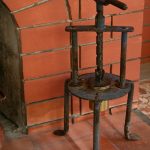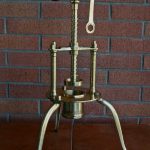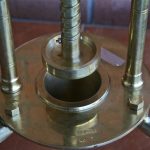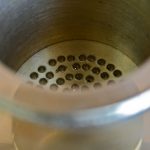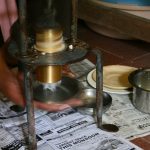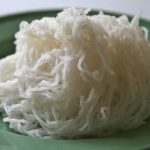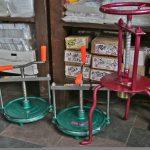On to the third of the three most popular puttus.
Nuuputtu (nuul, meaning thread) is made from a rice dough that’s pressed into thin strands that are then formed into small cakes. Nuuputtu has cousins all over South India. You’ll spot the family resemblance in a number of places: shavige in Mangalore and other parts of Karnataka and the Konkan coast, idiappam in Kerala, sevai or santhakkai in Tamil Nadu. The basic concept is the same – a cooked dough made from some form of rice, pressed into fine rice noodles. And yet, seemingly minor variations in the type of rice used and in the cooking process can produce quite distinctly different textures and unique flavours.
The Coorg nuuputtu is made from a cooked thari dough which is then steamed again before being pressed. Making nuuputtu requires a special kind of press known as a nuuputtu wara. The wara started out as a wooden press, which used raw strength to press the dough through a perforated die.
“This was men’s work” said Professor Appanna, not entirely in jest, when showing me his collection of wooden nuuputtu waras. Man or woman, it took strong shoulders to work the rice dough through those old wooden presses. These presses gave way to metal versions which use torque to power though the dough and reduce the effort required considerably. It’s still hard work, though. I’ve often contemplated inviting people over for a “nuuputtu party” where they can press out their own nuuputtu*!
My mother’s nuuputtu wara given to her by her mother about 40 years ago. It’s travelled far and wide, twirling out fragrant nuuputtus from the Nilgiris to the Himalayas, even relocating to England for a short while, before coming home to roost in Mercara. On one visit to Coorg, I took along it to a local hardware store that sells kitchen equipment. As soon as I set foot in the doorway, the proprietor started to shake his head, indicating he didn’t have anything like it in the store. There are new versions, but, as he pointed out, the one I brought in was completely handcrafted, down to the grooved shaft. Apparently, this kind of work is no longer done having given way to machine made versions. These shiny new models in the market work quite well, but they seem to lack some of the finer touches and practical features of the old. For instance, the suspended brass barrel that presses down into the dough so effectively – a double barrel, as it were – has been done away with in favour of a flat disc like that found in a murku press or an icing gun.
See those broad, flat feet on the old press? Well, the brassy belles these days have stylish little feet that look charming but don’t provide a toe hold for stabilizing the press in action. Well, really! Another model with spindly legs that seem to echo the wiggly rice noodles, comes fitted with a handle that wouldn’t look out of place in the innards of a WWII era submarine!
Still, they work, some more efficiently than others. And we’ll still make nuuputtu any way we can.
*Like François-Xavier of FX cuisine with his bigolaro.

